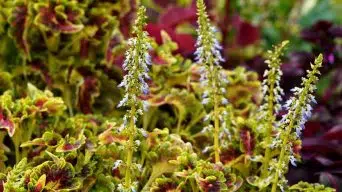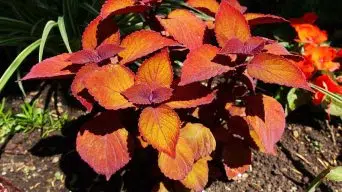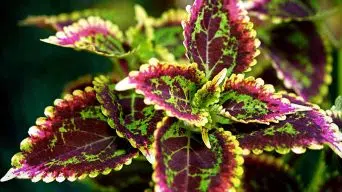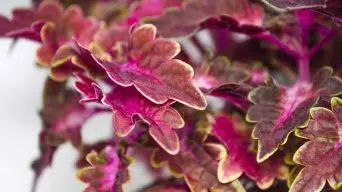Coleus plants are grown for their colorful leaves, which come in a wide range of colors and patterns. These plants are easy to care for and make excellent houseplants or annual bedding plants in the garden.
However, coleus plants can sometimes become leggy, with long stems and few leaves. This is usually caused by too little light or too much fertilizer.
In this article, you’ll find everything you need to know about how to fix a leggy coleus plant.
What Causes Coleus Plants to Become Leggy?
There are a few reasons why your coleus plant might be getting leggy.
The most common reasons are:
1. Too Little Light
A Coleus plants needs bright,indirect light to grow and thrive.
Coleus plants need at least 4 hours of bright, indirect light each day, but they will do best with 6-8 hours.
If you live in a mainly sunny climate, you may need to provide some afternoon shade to prevent the leaves from scorching.
Direct sunlight will cause the leaves to fade and may even cause them to develop brown patches.
If they don’t get enough light, they will become leggy as they stretch out toward the light source.
Light is essential for the plant to produce food through photosynthesis.
If the plant isn’t getting enough light, it will become thin and leggy as it tries to grow toward the light source.
2. Too Much Fertilizer
If you’re fertilizing your coleus plant too often, it can cause the plant to become leggy.
Coleus plants need to be fertilized once a month during the growing season.
If you’re fertilizing more often than that, you could be causing the plant to produce too much growth.
Also, using a high-nitrogen fertilizer will encourage the plant to grow faster, which can also cause the plant to become leggy.
The best way to avoid this is to use a balanced fertilizer formulated for coleus plants.
3. Lack of Pruning
Pruning is another important factor in keeping your coleus plant from becoming leggy.
If you don’t prune your plant, it will become tall and spindly.
Pruning encourages the plant to produce new growth, which will make the plant fuller and more bushier.
Coleus plants must be pruned every few weeks to prevent them from becoming leggy.
How To Tell If Your Coleus Plant Is Leggy
A few signs will tell you if your coleus plant is leggy.
The most common signs are:
1. The Plant Is Tall and Spindly
If your coleus plant is tall and spindly, it’s probably leggy.
A healthy coleus plant should be short and compact, with thick stems and plenty of leaves.
When the plant stretches out and becomes thin, it’s a sign that it isn’t getting enough light or too much fertilizer.
The lack of light will cause the plant to become leggy as it tries to reach the light source.
The excess fertilizer will cause the plant to produce too much growth, which will make the plant leggy.
2. The Plant Has Few Leaves
Another sign of a leggy plant is if it has few leaves.
A healthy coleus plant should have plenty of leaves, with new growth emerging from the center of the plant.
If the plant is leggy, you’ll notice that the leaves are sparse and far apart.
Light is essential for the plant to produce food through photosynthesis.
If the plant isn’t getting enough light, it won’t be able to produce enough leaves.
Fertilizer is also essential for the plant to produce new growth.
If you’re fertilizing too often, the roots can be damaged, preventing the plant from producing new growth.
3. The Leaves Are Small and Far Apart
If your plant’s leaves are small and far apart, it likely needs more light.
When coleus plants grow in low-light conditions, they produce smaller leaves spaced further apart.
The plant is trying to maximize the amount of light it’s getting by producing fewer, larger leaves.
If you want your plant to produce more leaves, you’ll need to provide it with more light.
4. The Plant Is Leaning to One Side
If your plant is leaning to one side, it’s probably not getting enough light.
When plants lean, they’re trying to get closer to the light source.
If your plant is leaning, you’ll need to provide it with more light.
You can also try staking the plant to help it stay upright.
5. The Plant Is Drooping
The lack of light can also cause the plant to droop. Light is essential for the plant to produce food through photosynthesis.
If the plant isn’t getting enough light, it will start to droop as it won’t have the energy to stay upright.
If your coleus leaves are drooping, you’ll need to provide it with more light or stake it to help it stay upright
6. The Plant Is Not Growing New Leaves
If your plant is not growing new leaves, it’s probably not getting enough light or fertilizer.
Coleus plants need both light and nutrients to produce new growth.
If the plant isn’t getting enough of either one, it won’t be able to produce new leaves.
If you want your plant to grow new leaves, you’ll need to provide it with more light and fertilizer.
7. The Plant Looks Weak and Sickly
If your plant looks weak and sickly, it’s probably not getting enough light or water.
A leggy coleus plant will have thin, weak stems and sickly-looking leaves.
If your plant looks like this, you’ll need to provide it with more light and water.
How To Fix a Leggy Coleus Plant
You can do a few things to fix a leggy coleus plant.
1. Prune the Plant
Pruning is a great way to encourage the plant to produce new growth.
When you prune a plant, you remove the old, leggy growth.
This forces the plant to produce new growth, which will be shorter and more compact.
To prune your coleus plant, cut back the leggy stems to the desired length.
You can also remove any leaves that are yellow or brown and any stems that are thin or weak.
2. Provide More Light
If your plant is leggy because it’s not getting enough light, you’ll need to provide it with more light.
You can do this by moving the plant to a brighter location.
Coleus plants thrive in bright, indirect light and need at least four hours of light per day.
An east- or west-facing window is a good option. This type of light is bright but not harsh, which is ideal for coleus plants.
You can try using grow lights if you can’t give your plant more light.
Grow lights are artificial lights that mimic the sunlight that plants need to grow.
They’re a great option if you cannot provide your plant with enough natural light.
3. Don’t Fertilize Too Often
Fertilizer is essential for the plant to produce new growth.
If you’re fertilizing too often, the roots can be damaged, preventing the plant from producing new growth.
It’s best to fertilize your coleus plant once a month during the growing season.
During the winter, you can stop fertilizing altogether.
Avoid using a fertilizer high in nitrogen, as this can cause the houseplant to grow faster than it can support, leading to leggy growth.
4. Stake the Plant
If your plant is leaning or drooping, you can try staking it.
Staking the plant will help it stay upright and prevent it from leaning or drooping.
To stake your plant, tie the stems to a bamboo stake or other support.
Ensure the support is tall enough that the plant won’t be leaning or drooping.
How To Prevent a Leggy Coleus Plant
You can do a few things to prevent your plant from becoming leggy.
1. Provide Enough Light
Coleus plants need bright, indirect sunlight to maintain their compact growth habit. If your plant is not getting enough light, it will become leggy as it stretches toward the sun.
Move your plant to a brighter spot, or provide supplemental artificial lighting.
You can place your coleus near an east- or west-facing window. This will provide the bright, indirect light it needs without exposing it to direct sun, which can scorch its leaves.
If you don’t have a spot that gets enough natural light, you can provide supplemental lighting with fluorescent grow lights.
Place the lights about 12 inches (30 cm) above the plant and leave them on for 12 to 16 hours daily.
2. Turn the Plant Regularly
Another way to prevent your coleus from becoming leggy is to turn the plant regularly. This will ensure that all sides of the plant get an equal amount of light.
Turn your plant about once a week so that the leaves on all sides have a chance to absorb light.
3. Pinch Off the Tips
Pinching off the tips of the Coleus plant will encourage it to branch out and become fuller. Use your fingers or scissors to snip off the tips of the stems, about 1/2 inch (1 cm) above a leaf node.
Do this every few weeks throughout the growing season.
4. Prune Regularly
Pruning your Coleus plant will encourage it to branch out and become fuller.
Use sharp pruning shears to snip off the tips of leggy stems. Make sure to cut just above a leaf node, which is the point where leaves emerge from the stem.
Pruning also helps to prevent your coleus from getting too big for its pot. Regular pruning will keep it compact and encourage new growth.
You can tell when your coleus needs pruning if the stems are getting long and leggy or if the plant is starting to look crowded and overgrown.
5. Fertilize Properly
Coleus plants need regular fertilization to stay healthy and promote compact growth.
Use a balanced fertilizer with an N-P-K ratio of 10-10-10 or 20-20-20. Dilute the fertilizer to half-strength and apply it once during the growing season.
If you see your Coleus plant becoming leggy, yellow, or stunted, this is a sign that it’s not getting enough nutrients. Feeding it a balanced fertilizer will help to color it up and promote compact growth.
Be sure to water your plant before applying fertilizer, and avoid getting any on the leaves to prevent burning.
6. Keep an Eye on Your Plant
The best way to prevent your Coleus plant from becoming leggy is to keep an eye on it and take action when you see the first signs of stretching.
Provide enough light, turn the plant regularly, pinch off the tips, prune periodically, and fertilize properly to encourage compact growth.
Final Thoughts
Coleus plants make beautiful houseplants and are relatively easy to take care of. However, like all plants, they can sometimes experience problems.
One common issue is leggy growth.
Thankfully, there are a few easy ways to fix a leggy coleus plant.
By trimming the plant back, increasing the light it receives, and regularly fertilizing it, you can encourage your coleus to grow fuller and bushier.
With some care, you can have a healthy and beautiful coleus plant that will add life to any room in your home.







